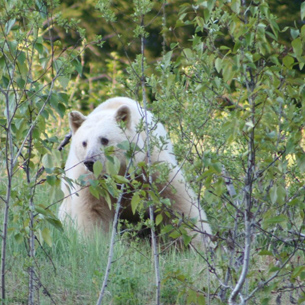Module 8
1. Module 8
1.14. Page 3
Module 8—Populations, Individuals, and Gene Pools
 Read
Read
Read pages 681 to 685 of your textbook to review these concepts and calculations. It can be challenging, but practising problem solving will ensure your mastery of this material. Answer the questions on page 683 of your textbook and discuss your work with your teacher.
 Watch and Listen
Watch and Listen
You have viewed parts of the following videos in the previous lessons in this unit. You may wish to view all of these videos as a review or concentrate on the sections listed:
- Gene Frequencies, Natural Selection and Speciation: “The Burgess Ghosts”
- The Hardy-Weinberg Principle: “Minding Your p’s and q’s”
Remember that your success in this concept depends on your ability to successfully solve problems. Practice is essential to mastery.
 Self-Check
Self-Check

© Roberta Taylor
The “Spirit Bear” or Kermode bear is a pure white mutant of the American black bear that is found on Princess Royal Island off the central BC coast. First Nations all along the coast believe in the special powers of the bear and hold it in high regard. The following problems study the frequency of the normal dark allele and the recessive white allele. For the purposes of these problems assume A is the allele for black fur and a is the allele for white fur.
For each of the four Self-Check questions, first decide which of the following Hardy-Weinberg symbols you’ve been given in the question. Then, decide which symbol you want to find. Then, use p + q = 1 and p2 + 2pq + q2 = 1 to solve for your answer.
p q p2 2pq q2
f(A) f(a) f(AA) f(Aa) f(aa)
SC 1. If 45 of 75 bears in a local Princess Royal Island population have the recessive phenotype of white fur, what is the frequency of the recessive allele in the bear’s gene pool?
SC 2. What percentage of the population of bears are heterozygotes?
SC 3. How many bears are pure-breeding for the black phenotype?
SC 4. If ten years ago, only 24 of 77 bears were white, has microevolution occurred? Justify your answer.
 Self-Check Answers
Self-Check Answers
SC 1.
Given
The population of bears with the recessive phenotype is 45/75 or 0.6; therefore, these bears have the genotype of aa. The frequency of aa or f(aa) is symbolized by q2, so you’re given q2 = 0.6.
Required
The frequency of the recessive allele, or f(a), so you want to find q.
Solution
Find the square root of q2 to get q = 0.77.
Answer
q = 0.77
If the questions had asked for the % frequency, your answer would be that 77% of the alleles in the gene pool are recessive.
SC 2.
Given
The population of bears with the recessive phenotype is 45/75 or 0.6; therefore, these bears have the genotype of aa. So, you’re given q2 = 0.6.
Required
the percentage of bears of the heterozygous genotype (Aa) in the population, so you want 2pq
Solution
Square root q2 to get q. (q = 0.77)
p + q = 1, so 1 − q = p (p = 0.23)
2pq = 2(0.23)(0.77) = 0.35
Answer
The percentage of bears in this population that are heterozygotes is 35%.
SC 3.
Given
The population of bears with the recessive phenotype is 45/75 or 0.6; therefore, these bears have the genotype of aa. q2 = f(aa) So, you’re given q2 = 0.6.
Required
frequency of bears that are pure-breeding for the black phenotype, or f(AA), so you want p2
Solution
The square root of q2 gives you q.
q = 0.77
p + q = 1, so 1 − q = p
p = 0.23
p2 = f(AA) = 0.05
Answer
0.05
If the questions had asked for % frequency, then 5% of the 75 bears are pure-breeding for black hair. Therefore, 6 of the 75 bears are pure-breeding for black fur.
SC 4. By definition, microevolution has occurred if the allele frequencies (p and q) have changed, so you have to find p and q for these two dates and compare them.
Given
bears with white fur ten years ago = f(aa) or q2 = 24/77 = 0.31
Required
the frequency of the allele for white fur ten years ago = q
Solution
q2 = 0.31
q = 0.56
q ten years ago = 0.56
question 3 told us that q now = 0.77
Answer
Yes, microevolution has definitely occurred because the frequency of the allele for white fur has increased from 0.56 to 0.77.